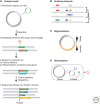Coevolution of the Organization and Structure of Prokaryotic Genomes
- PMID: 26729648
- PMCID: PMC4691797
- DOI: 10.1101/cshperspect.a018168
Coevolution of the Organization and Structure of Prokaryotic Genomes
Abstract
The cytoplasm of prokaryotes contains many molecular machines interacting directly with the chromosome. These vital interactions depend on the chromosome structure, as a molecule, and on the genome organization, as a unit of genetic information. Strong selection for the organization of the genetic elements implicated in these interactions drives replicon ploidy, gene distribution, operon conservation, and the formation of replication-associated traits. The genomes of prokaryotes are also very plastic with high rates of horizontal gene transfer and gene loss. The evolutionary conflicts between plasticity and organization lead to the formation of regions with high genetic diversity whose impact on chromosome structure is poorly understood. Prokaryotic genomes are remarkable documents of natural history because they carry the imprint of all of these selective and mutational forces. Their study allows a better understanding of molecular mechanisms, their impact on microbial evolution, and how they can be tinkered in synthetic biology.
Copyright © 2016 Cold Spring Harbor Laboratory Press; all rights reserved.
Figures




Similar articles
-
Natural selection for operons depends on genome size.Genome Biol Evol. 2013;5(11):2242-54. doi: 10.1093/gbe/evt174. Genome Biol Evol. 2013. PMID: 24201372 Free PMC article.
-
Genome alignment, evolution of prokaryotic genome organization, and prediction of gene function using genomic context.Genome Res. 2001 Mar;11(3):356-72. doi: 10.1101/gr.gr-1619r. Genome Res. 2001. PMID: 11230160
-
Gene organization: selection, selfishness, and serendipity.Annu Rev Microbiol. 2003;57:419-40. doi: 10.1146/annurev.micro.57.030502.090816. Annu Rev Microbiol. 2003. PMID: 14527286 Review.
-
Assessing the benefits of horizontal gene transfer by laboratory evolution and genome sequencing.BMC Evol Biol. 2018 Apr 19;18(1):54. doi: 10.1186/s12862-018-1164-7. BMC Evol Biol. 2018. PMID: 29673327 Free PMC article.
-
Ancient origin of the tryptophan operon and the dynamics of evolutionary change.Microbiol Mol Biol Rev. 2003 Sep;67(3):303-42, table of contents. doi: 10.1128/MMBR.67.3.303-342.2003. Microbiol Mol Biol Rev. 2003. PMID: 12966138 Free PMC article. Review.
Cited by
-
Vibrio cholerae chromosome 2 copy number is controlled by the methylation-independent binding of its monomeric initiator to the chromosome 1 crtS site.Nucleic Acids Res. 2018 Nov 2;46(19):10145-10156. doi: 10.1093/nar/gky790. Nucleic Acids Res. 2018. PMID: 30184118 Free PMC article.
-
Towards functional characterization of archaeal genomic dark matter.Biochem Soc Trans. 2019 Feb 28;47(1):389-398. doi: 10.1042/BST20180560. Epub 2019 Feb 1. Biochem Soc Trans. 2019. PMID: 30710061 Free PMC article. Review.
-
Too Much of a Good Thing: How Ectopic DNA Replication Affects Bacterial Replication Dynamics.Front Microbiol. 2020 Apr 15;11:534. doi: 10.3389/fmicb.2020.00534. eCollection 2020. Front Microbiol. 2020. PMID: 32351461 Free PMC article. Review.
-
Laboratory evolution of the bacterial genome structure through insertion sequence activation.Nucleic Acids Res. 2025 May 10;53(9):gkaf331. doi: 10.1093/nar/gkaf331. Nucleic Acids Res. 2025. PMID: 40347137 Free PMC article.
-
Genome Complexity Browser: Visualization and quantification of genome variability.PLoS Comput Biol. 2020 Oct 9;16(10):e1008222. doi: 10.1371/journal.pcbi.1008222. eCollection 2020 Oct. PLoS Comput Biol. 2020. PMID: 33035207 Free PMC article.
References
-
- Abby S, Daubin V. 2007. Comparative genomics and the evolution of prokaryotes. Trends Microbiol 15: 135–141. - PubMed
Publication types
MeSH terms
Grants and funding
LinkOut - more resources
Full Text Sources
Other Literature Sources
